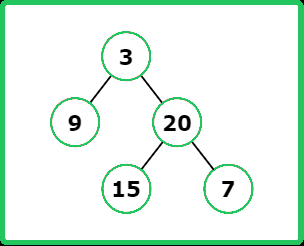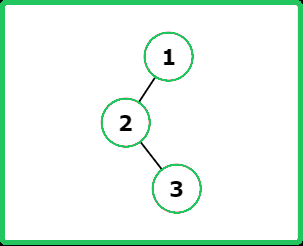1234567891011121314151617181920212223242526272829303132333435363738394041424344454647484950515253545556575859606162636465666768697071727374
#include <bits/stdc++.h>
using namespace std;
// Definition for a binary tree node.
struct TreeNode {
int data;
TreeNode *left;
TreeNode *right;
TreeNode(int val) : data(val), left(nullptr), right(nullptr) {}
};
class Solution {
public:
// Function to check if the tree is balanced
bool isBalanced(TreeNode *root) {
// Check if the tree's height difference
// between subtrees is less than 2
// If not, return false; otherwise, return true
return dfsHeight(root) != -1;
}
private:
// Recursive function to calculate the height of the tree
int dfsHeight(TreeNode *root) {
// Base case: if the current node is NULL,
// return 0 (height of an empty tree)
if (root == nullptr) return 0;
// Recursively calculate the height of the left subtree
int leftHeight = dfsHeight(root->left);
// If the left subtree is unbalanced,
// propagate the unbalance status
if (leftHeight == -1) return -1;
// Recursively calculate the height of the right subtree
int rightHeight = dfsHeight(root->right);
// If the right subtree is unbalanced,
// propagate the unbalance status
if (rightHeight == -1) return -1;
// Check if the difference in height between left and right subtrees is greater than 1
// If it's greater, the tree is unbalanced,
// return -1 to propagate the unbalance status
if (std::abs(leftHeight - rightHeight) > 1) return -1;
// Return the maximum height of left and right subtrees, adding 1 for the current node
return std::max(leftHeight, rightHeight) + 1;
}
};
// Main function
int main() {
// Creating a sample binary tree
TreeNode* root = new TreeNode(1);
root->left = new TreeNode(2);
root->right = new TreeNode(3);
root->left->left = new TreeNode(4);
root->left->right = new TreeNode(5);
root->left->right->right = new TreeNode(6);
root->left->right->right->right = new TreeNode(7);
// Creating an instance of the Solution class
Solution solution;
// Checking if the tree is balanced
if (solution.isBalanced(root)) {
std::cout << "The tree is balanced." << std::endl;
} else {
std::cout << "The tree is not balanced." << std::endl;
}
return 0;
}
12345678910111213141516171819202122232425262728293031323334353637383940414243444546474849505152535455565758596061626364656667686970717273747576777879
/**
* Definition for a binary tree node.
* public class TreeNode {
* int data;
* TreeNode left;
* TreeNode right;
* TreeNode(int val) { data = val; left = null; right = null; }
* }
**/
class Solution {
/**
* Checks if the binary tree is balanced.
* A binary tree is considered balanced if the height difference between
* the left and right subtrees of every node is at most 1.
*
* @param root The root node of the binary tree.
* @return true if the tree is balanced, false otherwise.
*/
public boolean isBalanced(TreeNode root) {
// Call the recursive helper method to check balance status.
// If the heightDifference() returns -1, the tree is unbalanced.
return dfsHeight(root) != -1;
}
/**
* Recursive method to calculate the height of the tree.
* Returns -1 if the tree is unbalanced, otherwise returns the height of the tree.
*
* @param root The current node of the tree.
* @return The height of the tree if balanced, -1 if unbalanced.
*/
private int dfsHeight(TreeNode root) {
// Base case: If the current node is null, the height of an empty tree is 0.
if (root == null) return 0;
// Recursively calculate the height of the left subtree.
int leftHeight = dfsHeight(root.left);
// If the left subtree is unbalanced, propagate the unbalance status.
if (leftHeight == -1) return -1;
// Recursively calculate the height of the right subtree.
int rightHeight = dfsHeight(root.right);
// If the right subtree is unbalanced, propagate the unbalance status.
if (rightHeight == -1) return -1;
// Check if the difference in height between the left and right subtrees is greater than 1.
// If the difference is greater, the tree is unbalanced.
if (Math.abs(leftHeight - rightHeight) > 1) return -1;
// Return the height of the tree rooted at the current node.
return Math.max(leftHeight, rightHeight) + 1;
}
}
// Main class for testing the Solution class
public class Main {
public static void main(String[] args) {
// Creating a sample binary tree
TreeNode root = new TreeNode(1);
root.left = new TreeNode(2);
root.right = new TreeNode(3);
root.left.left = new TreeNode(4);
root.left.right = new TreeNode(5);
root.left.right.right = new TreeNode(6);
root.left.right.right.right = new TreeNode(7);
// Creating an instance of the Solution class
Solution solution = new Solution();
// Checking if the tree is balanced
if (solution.isBalanced(root)) {
System.out.println("The tree is balanced.");
} else {
System.out.println("The tree is not balanced.");
}
}
}
123456789101112131415161718192021222324252627282930313233343536373839404142434445464748495051525354555657585960616263
# Definition for a binary tree node.
class TreeNode:
def __init__(self, val=0, left=None, right=None):
self.val = val
self.left = left
self.right = right
class Solution:
def isBalanced(self, root):
# Function to check if the tree is balanced
def dfsHeight(root):
# Base case: if the current node is None,
# return 0 (height of an empty tree)
if not root:
return 0
# Recursively calculate the height of the left subtree
leftHeight = dfsHeight(root.left)
# If the left subtree is unbalanced,
# propagate the unbalance status
if leftHeight == -1:
return -1
# Recursively calculate the height of the right subtree
rightHeight = dfsHeight(root.right)
# If the right subtree is unbalanced,
# propagate the unbalance status
if rightHeight == -1:
return -1
# Check if the difference in height between left and right subtrees is greater than 1
# If it's greater, the tree is unbalanced,
# return -1 to propagate the unbalance status
if abs(leftHeight - rightHeight) > 1:
return -1
# Return the maximum height of left and right subtrees, adding 1 for the current node
return max(leftHeight, rightHeight) + 1
# Check if the tree's height difference between subtrees is less than 2
# If not, return False; otherwise, return True
return dfsHeight(root) != -1
# Main function
if __name__ == "__main__":
# Creating a sample binary tree
root = TreeNode(1)
root.left = TreeNode(2)
root.right = TreeNode(3)
root.left.left = TreeNode(4)
root.left.right = TreeNode(5)
root.left.right.right = TreeNode(6)
root.left.right.right.right = TreeNode(7)
# Creating an instance of the Solution class
solution = Solution()
# Checking if the tree is balanced
if solution.isBalanced(root):
print("The tree is balanced.")
else:
print("The tree is not balanced.")
123456789101112131415161718192021222324252627282930313233343536373839404142434445464748495051525354555657585960616263646566676869707172
/**
* Definition for a binary tree node.
* class TreeNode {
* constructor(val = 0, left = null, right = null) {
* this.data = val;
* this.left = left;
* this.right = right;
* }
* }
**/
class Solution {
// Function to check if the tree is balanced
isBalanced(root) {
// Helper function to calculate the height of the tree
const dfsHeight = (root) => {
// Base case: if the current node is null,
// return 0 (height of an empty tree)
if (root === null) return 0;
// Recursively calculate the height of the left subtree
const leftHeight = dfsHeight(root.left);
// If the left subtree is unbalanced,
// propagate the unbalance status
if (leftHeight === -1) return -1;
// Recursively calculate the height of the right subtree
const rightHeight = dfsHeight(root.right);
// If the right subtree is unbalanced,
// propagate the unbalance status
if (rightHeight === -1) return -1;
// Check if the difference in height between left and right subtrees is greater than 1
// If it's greater, the tree is unbalanced,
// return -1 to propagate the unbalance status
if (Math.abs(leftHeight - rightHeight) > 1) return -1;
// Return the maximum height of left and right subtrees, adding 1 for the current node
return Math.max(leftHeight, rightHeight) + 1;
}
// Check if the tree's height difference between subtrees is less than 2
// If not, return false; otherwise, return true
return dfsHeight(root) !== -1;
}
}
// Main function
function main() {
// Creating a sample binary tree
const root = new TreeNode(1);
root.left = new TreeNode(2);
root.right = new TreeNode(3);
root.left.left = new TreeNode(4);
root.left.right = new TreeNode(5);
root.left.right.right = new TreeNode(6);
root.left.right.right.right = new TreeNode(7);
// Creating an instance of the Solution class
const solution = new Solution();
// Checking if the tree is balanced
if (solution.isBalanced(root)) {
console.log("The tree is balanced.");
} else {
console.log("The tree is not balanced.");
}
}
// Execute the main function
main();



